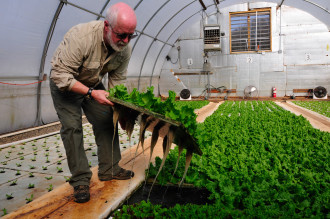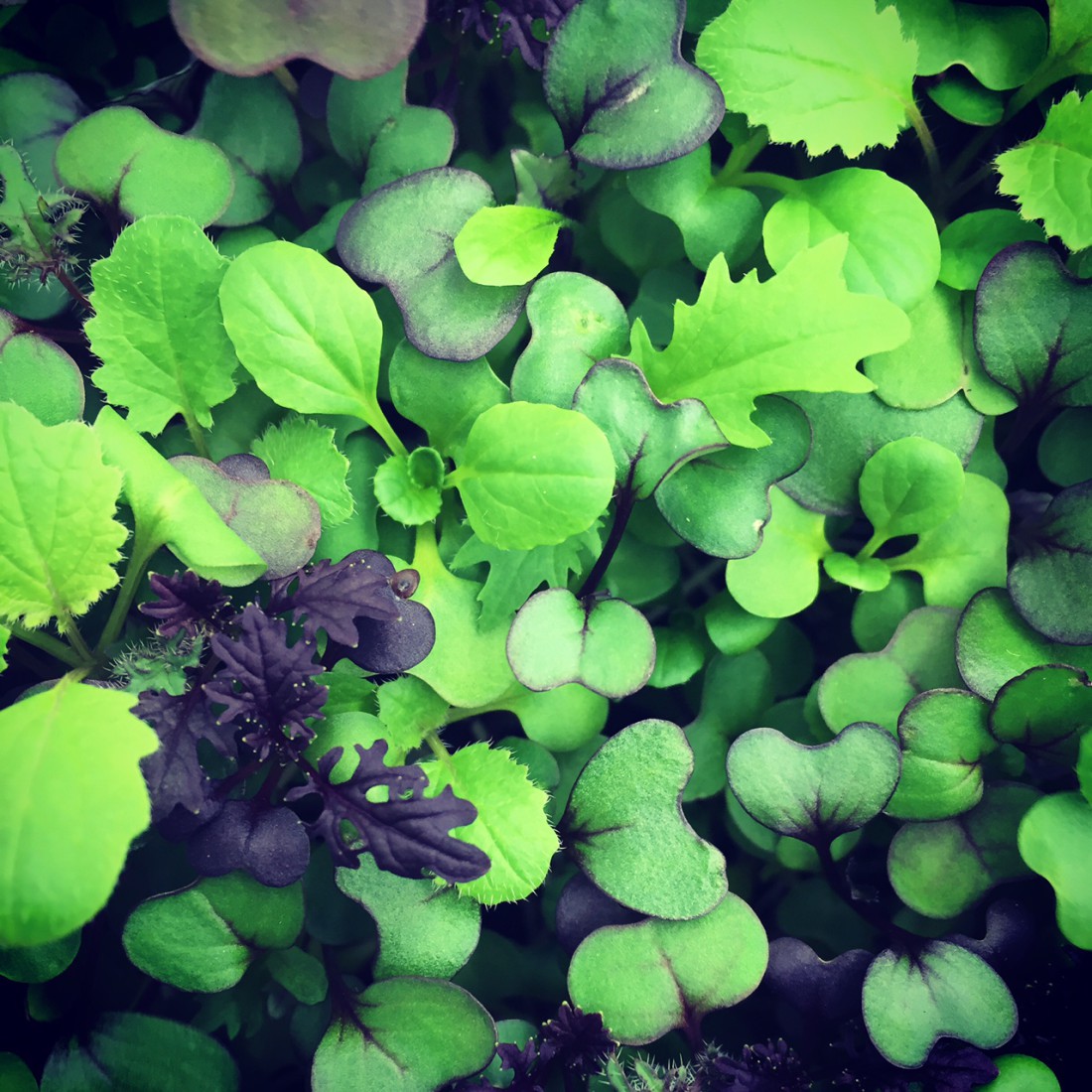When Eli Herman first started growing microgreens for Biltmore 18 years ago, the teeny vegetables weren’t yet a big thing. In fact, only one estate chef was using them, a chef who, to keep putting them on plates, needed to cut out overnight shipping costs from a distant supplier. But today, diners are eating them up: As field-to-table manager, Herman produces an average of 12 pounds a week throughout the year (a number higher in peak seasons) for the property’s many restaurants — quite an impressive volume considering the greens are measured by the ounce and relatively weightless. What’s more, he grows nearly all of the microgreens Biltmore uses, upward of 90 percent.

“We saw some potential for them,” Herman explains of his and the lone chef’s choice to go for it more than a decade ago. “Part of my job in working with the chefs on the property is to subscribe to restaurant magazines. … As they start predicting things that are ‘trendy,’ I gear up at least two to three seasons in advance to figure out the economics and technique for production.”
Thankfully for Herman, microgreens haven’t been a boom-and-bust phenomenon, although he acknowledges their popularity has grown more slowly off the estate than on — something Wesley Sleight of Sleight Family Farm can attest to.
He and his wife, Anna, moved to McDowell County about four years ago. “We came and scouted all the farmers markets before we moved, just to see what people were doing and what the market climate was like,” Sleight says. Even then, he notes, nobody was really offering microgreens. But sure enough, by the time they got their production underway, a few other farmers had the tiny-yet-mighty greens at their tailgate booths, too. This season, a search for “microgreens” in the Local Food Guide published by the Appalachian Sustainable Agriculture Project turns up 43 Appalachian Grown farmers listing them as an offering.
Why go micro?
From a consumer/culinary perspective, microgreens’ increasing popularity comes as no surprise to Herman and Sleight. They both cite the intense flavor, attractive appearance, appealing texture, and nutrient density — microgreens can pack a punch up to 40 times more nutritionally powerful than their full-grown counterparts. Sleight has even heard of doctors prescribing his greens to their patients.
“They add pizzazz to basically any meal,” he says. “And they have much more depth to them than light, watery sprouts.”
Though they look similar, microgreens and sprouts aren’t one in the same, Herman stresses. “Microgreens are the first true leafed stage [of the plant], and just the stems and leaves, not the roots,” he says, noting that a true sprout is the whole shebang.
Any green can be grown to and harvested at micro status: Think kale, pea greens and broccoli. Like lettuces, microgreens are often packaged as mixes, too — from braising mix with mustards and Asian greens to spicy combinations of arugula and radishes.
Sleight says a lot of shoppers are drawn to his sunflower greens in particular, which he describes as incredibly juicy. They’re more difficult to cultivate than other microgreens, though, as they hold onto their seed hull throughout maturation, which requires extra processes for farmers during growing and harvesting.
Despite that, from a grower’s perspective, Sleight says going micro is huge fun. “You can play with hundreds of different varieties of plants and it’s only a two-week turnover. That allows us to be nimble as farmers; we can customize our growing really efficiently.”
Because they’re grown in a protected greenhouse environment, microgreens also offer growers a year-round product — vital for Biltmore, which boasts its busiest season over the winter holidays, when field production is at a standstill.
And microgreens are a fairly sustainable option, no matter how you grow them.
To soil or not to soil?
Herman and Sleight represent two sides of the microgreens divide. Herman grows hydroponically, while Sleight plants in soil. Both, however, are eco-friendly in their endeavors.
“We’re moving toward hydroponics for the majority of our field-to-table garden production because I personally feel it’s more environmentally sound than field production,” Herman says. Why? All of the nutrients are contained, he says, so he doesn’t worry about fertilizers running off into water sources and creating algae blooms. Because the greenhouses are screened, he’s all but eliminated insects and the need for pesticides. And, he says, he actually uses less water per crop in his hydroponic greenhouses than in field production, which requires watering ground that’s not producing any vegetables. Herman’s preferred growing medium for the greens is an untreated burlap, an entirely compostable substance that gets reworked back into the soil elsewhere on the estate.

Sleight swears by soil: “We’ve experimented with a bunch of different kinds, but we’ve grown really fond of a certain type of soil with natural mineral amendments. … It just nourishes the greens really well.” He adds that after growing both in soil and hydroponically, he believes the former produces a more flavorful green, with what he thinks is a more agreeable texture. Soil, he finds, also seems to extend shelf life — from just four to five days to closer to two weeks (although, he says, the greens are always best the sooner they’re consumed, a good reason to get them at a farmers market versus a grocery store).
He acknowledges that the purchased soil is an off-farm input — the microgreens need a pure soil, otherwise, they can foster mold easily — and that plays a role in their sustainability factor. To offset this, the couple are applying for North Carolina rural energy grants to help reduce their carbon footprint; if received, they’ll install solar panels to power their heating and cooling system, fans, and lights. “As we evolve in this whole process, we’re always scrutinizing how to make things more efficient and more eco,” Sleight says.
Get growing?
Having previously taught microgreens classes at the Organic Growers School, Herman knows those interested in growing the greens at home can find success. He advises that microgreens kits may be the way to go, noting that Ikea even has a tabletop hydroponics system that could help make things reasonably simple. Lighting is the trickiest part, he notes, because getting it just right is necessary to ensure good green color and that the plant isn’t all stem and no leaf.

For Sleight, the initial setup wasn’t too challenging. But as he began to grow more and more types of microgreens, he found that they do each have their own nuances, which can present a learning curve. In addition to light, he says some types need less water than others or a different amount of airflow. It takes trial and error.
For farmers thinking about growing commercially, Herman reminds growers of the capital investment needed to begin, emphasizing that it’s important to identify the market first and get a commitment, then start small.
That’s the route Sleight took, and it has worked for him and his family, who are now branching out into the production of field crops. “Microgreens got our foot in the door with markets and got us introduced to restaurants,” he says. “It has been awesome to see it take off from something that we really loved and had passion for as customers … and to be able to share that with the general public; we think it’s a good, vital product.”




Forward